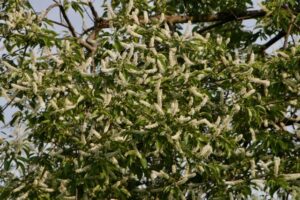black cherry
Prunus serotina

Description:
Prunus serotina, commonly known as black cherry, is a deciduous tree native to Wisconsin. It belongs to the Rosaceae family and is widely distributed across the eastern and central parts of the continent, ranging from Canada to Florida and as far west as Texas.
The black cherry tree typically reaches a height of 50 to 80 feet (15 to 24 meters) and has an upright, pyramidal or oval-shaped crown. Its bark is smooth and reddish-brown when young, gradually becoming darker and developing distinctive horizontal lenticels as the tree matures. The leaves are simple, alternate, and elliptical in shape, measuring 2 to 5 inches (5 to 13 centimeters) long. They have finely serrated margins and a glossy dark green color, turning yellow to red in the fall.
In spring, black cherry trees produce clusters of small, fragrant white flowers that attract pollinators such as bees and butterflies. These flowers give way to dark purple to black cherries that ripen in late summer. The fruit is approximately ¼ to ⅓ inch (0.6 to 0.8 centimeters) in diameter and is a food source for birds and mammals.
Overall, Prunus serotina is a resilient and adaptable tree that thrives in a variety of habitats, including woodlands, forests, and open fields. It plays an important ecological role, providing food and habitat for wildlife. The wood of black cherry trees is highly valued for its attractive grain and is commonly used in furniture making and woodworking.
Details:
wild black cherry
| USDA Symbol: | Common Name: | Scientific Name: |
|---|---|---|
| PRSE2 | black cherry | Prunus serotina |
ITIS TSN: 24764
Category: Dicot
Taxonomy
Kingdom: Plantae
Subkingdom:
Super Division: Spermatophyta
Division: Magnoliophyta
Subdivision:
Class: Magnoliopsida
SubClass: Rosidae
Order: Rosales
Family: Rosaceae
Counties: Adams, Ashland, Barron, Bayfield, Brown, Buffalo, Burnett, Calumet, Chippewa, Clark, Columbia, Crawford, Dane, Dodge, Door, Douglas, Dunn, Eau Claire, Florence, Fond du Lac, Forest, Grant, Green, Green Lake, Iowa, Iron, Jackson, Jefferson, Juneau, Kenosha, Kewaunee, La Crosse, Lafayette, Langlade, Lincoln, Manitowoc, Marathon, Marinette, Marquette, Menominee, Milwaukee, Monroe, Oconto, Oneida, Outagamie, Ozaukee, Pepin, Pierce, Portage, Price, Racine, Richland, Rock, Rusk, Sauk, Sawyer, Shawano, Sheboygan, St. Croix, Taylor, Trempealeau, Vernon, Vilas, Walworth, Washburn, Washington, Waukesha, Waupaca, Waushara, Winnebago, Wood
| Duration: | Growth Habit: | Native Status: |
|---|---|---|
| Perennial | Tree, Shrub | L48(N)CAN(N) |
| NR40 Listed Plant | Noxious Weed: | Invasive Species (NR40): | Threatened/Endangered: | WI Natural Heritage Index: | Wetland Status |
|---|---|---|---|---|---|
| Native | FACU |
Active Growth Period: Spring and Summer
Bloat: Low
Carbon to Nitrogen Ratio: High
Coppice Potential: Yes
Conspicuous Fall Color: No
Fire Resistant: No
Flower Color: White
Conspicuous Flower: Yes
Foliage Color: Green
Foliage Light Porosity Summer: Moderate
Foliage Porosity Winter: Porous
Foliage Texture: Medium
Fruit/Seed Color: Black
Growth Form: Multiple Stem
Growth Rate: Rapid
Height at Base Age (Max): 40
Known Alelopath: No
Leaf Retention: No
Lifespan: Moderate
Re-sproutability: Yes
Shape and Orientation: Erect
Toxicity: Severe
Height (min):
Height (max):
Root Type:
Leaf Type:
Leaf Arrangement:
Leaf Shape:
Vein Pattern:
Adapted to Coarse Textured Soils: Yes
Adapted to Medium Textured Soils: Yes
Adapted to Fine Textured Soils: No
CaCO3 Tolerance: High
Cold Stratification Required: Yes
Drought Tolerance: Medium
Fertility Requirement: Medium
_Fire Tolerance: Low
Hedge Tolerance: None
Moisture Use: Medium
pH (Minimum): 4
pH (Maximum): 7.5
Planting Density per Acre, Minimum: 300
Planting Density per Acre, Maximum: 800
Precipitation (Minimum): 21
Precipitation (Maximum): 50
Root Depth, Minimum (inches): 36
Salinity Tolerance: Medium
Shade Tolerance: Intolerant
Temperature, Minimum (°F): -33
Plant Spacing (min):
Plant Spacing (max):
| Bloom Period: | Commercial Availability: | Fruit/Seed Abundance: |
|---|---|---|
| Late Spring | Routinely Available | High |
| Fruit/Seed Period Begin: | Fruit/Seed Period End: | Fruit/Seed Persistence: |
|---|---|---|
| Summer | Summer | No |
| Propogated by Bare Root: | Propogated by Bulbs: | Propogated by Container: |
|---|---|---|
| Yes | No | Yes |
| Propogated by Corms: | Propogated by Cuttings: | Propogated by Seed: |
|---|---|---|
| No | No | Yes |
| Propogated by Sod: | Propogated by Sprigs: | Propogated by Tubers: |
|---|---|---|
| No | No | No |
| Seeds per Pound: | Seed Spread Rate: | Seedling Vigor: |
|---|---|---|
| 4800 | Rapid | High |
| Small Grain: | Vegetative Spread Rate: | Propagation Treatment: |
|---|---|---|
| No | None |
| Days to Stratify: | Direct Sowing Time: |
|---|---|
Benefits:
| Berry/Nut/Seed Product: | Christmas Tree Product: | Fodder Product: |
|---|---|---|
| No | No | No |
| Fuelwood Product: | Lumber Product: | Naval Store Product: |
|---|---|---|
| High | Yes | Yes |
| Nursery Stock Product: | Palatable Browse Animal: | Palatable Graze Animal: |
|---|---|---|
| Yes | Low | Low |
| Palatable Human: | Post Product: | Protein Potential: |
|---|---|---|
| Yes | No | Low |
| Pulpwood Product: | Veneer Product: |
|---|---|
| No | Yes |
| Benefits: | Wildlife Food Value: | Wildlife Cover Value: |
|---|---|---|
References:
- iNaturalist – Prunus serotina
- Lady Bird Johnson Wildflower Center – Prunus serotina
- NRCS Plant Guide – Prunus serotina
- USDA Plants Database – Prunus serotina
- WisFlora Database – Prunus serotina
Return to Native Plants page
